
-
I've Found a Baby Bird!
Use this quick step-by-step guide to find out if the bird you've found needs help, and if so where to find assistance.
-
What Should I Do...?
Useful information on how to resolve some common situations involving altricial baby birds.
-
How Can I Help?
There are many ways that you can make a critical difference for baby birds. Please take action today!
-
In My Neighbourhood
A guide to the wonderful and varied baby birds you can find right in your own back yard!
-
About T.W.C.
Since 1993, Toronto Wildlife Centre has helped many thousands of wild animals in need. Find out more about the work we do.
HelpBabyBirds.ca
Copyright © 2010 Toronto Wildlife Centre.
In My Neighbourhood
European Starlings

Adult Starling
Though not everybody knows starlings by name, they are a familiar face to both city and country dwellers. These stocky brown birds were first introduced to North America in 1890 - a flock was set free in Central Park, by a group who wanted to introduce all the species mentioned in Shakespeare's plays to North America, and our millions of resident starlings are all descended from that same group!

Baby Starling
Starlings have small white spots on their feathers in the winter, and in the summer they develop a gorgeous iridescent sheen with purple and green hues. Adult starlings have yellow beaks, and young babies are characterized by bright yellow mouths and prominent yellow gape flanges (skin along the sides of the beak). People often describe baby starlings as having big yellow "lips."

A Capped Dryer Vent
Starlings are clever birds who have adapted amazingly well to city environments. They frequently nest in man-made cavities, such as air vents, damaged roofs, and even traffic lights! They also have a complex vocal apparatus and can make a wide range of sounds. Starlings can mimic the sounds of many other birds as well as environmental sounds and even human voices.
If you hear baby birds chirping in your walls, most times it is a starling nest. Be patient with your new baby neighbours during this process - they can be noisy, but they don't normally cause any damage and they won't be there for long. Baby starlings leave the nest for good when they are about 3 weeks old. After the babies have left the nest and there's no more activity at the entrance hole (you can test this by loosely taping a single piece of newspaper over the hole - if nothing rips through it in 24 hours, you can assume the entrance is not being used), then you can close off the hole if you wish with some wire mesh and screws or staples. If you can reach the nest, wear gloves and a face mask and remove the nest before blocking the hole, so it doesn't attract bugs. If it is a dryer vent, leave the bottom of the mesh open so the lint doesn't get trapped inside the mesh and cause a fire hazard.
House Sparrows
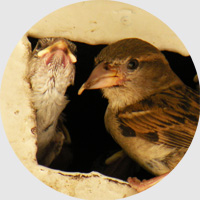
House Sparrow
The name of these familiar birds comes from their long-time success at living near people (and therefore in areas around the house). House sparrows often eat grains and seeds from crops and birdfeeders, as well as garden-grown and wild plants, but they're also not too proud to clean up the many delicious morsels that humans waste. These birds nest in cavities, and you'll often find them raising their young in utility poles, building holes, and crevices behind store signs.
Male and female house sparrows look different from one another (this feature of difference between the sexes is known as sexual dimorphism - humans have it too, of course, but in many species it is hard to tell girls from boys). Male house sparrows have a light grey belly, a rust and black back, white cheeks, a grey cap, and are bold black over the eyes and throat. Females are a uniform grayish-brown all over. It's not hard to tell which sex needs to impress the other in this species!
House sparrows love to take dust baths - take a look in the dusty patches along fences and in city parks, you might see a house sparrow nestling into a patch of earth and wiggling around to kick up a cloud of dust. It's quite a show!
Baby sparrows leave the nest when they are only two weeks old, and sometimes even younger. These fledglings often cannot fly well (or at all) when they leave the nest, but as long as they can hop around well on their own, they are OK to be on the ground. Like other songbirds, the parents still feed and care for their young after they leave the nest.
Rock Pigeons
Pigeons are one of our most common urban birds. In fact they're so common that many of us tend to not really look at them, which is a rather unfortunate loss, because pigeons are really stunning! They come in a wide variety of colours - if you take a look at a flock of pigeons you'll often see white, grey, brown, and spotted birds; you may also see some with little quirks like upturned feathers on their heads or longer feathers around their feet.
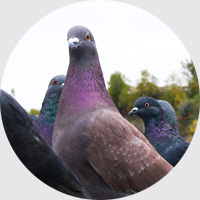
A Flock of Pigeons
Rock pigeons get their name from the rocky cliffs where they make their nests. In cities, of course, we don't have too many cliffs, so these adaptable birds happily make use of concrete balconies and window ledges instead. They can't perch well on skinny branches, and prefer nice flat areas to strut around.
Pigeons are strong fliers with excellent homing abilities - humans used to depend heavily upon them to deliver messages across long distances. (In fact, pigeons have saved many human lives in wars by carrying messages across battlefields - one pigeon particularly famous for this was Cher Ami.)
Males and females look the same, though you can tell them apart if you catch a glimpse of a courting ritual: males puff up their chests and bow to the females, and then prance around her in a circle, or follow her closely when she walks. (The coy females usually look like they want nothing to do with the whole business.) Couples mate for life, and raise several nests of (usually 2) babies over the course of each year, beginning in early spring and going through to early fall.
The chicks are covered with fine yellow hairs when born, which later stick out through their feathers. Babies make a high-pitched breathy peeping sound, but just like humans, their voice changes when they become teenagers. For a short while before they develop the soft “cooooo” of adulthood, their babyish peep becomes a nasally honk, much like a goose! Babies leave the nest when they are 3-4 weeks old, sometimes before they can fly very well.
Pigeons nests are usually a small, haphazard jumble of twigs (because they are built on flat surfaces, the nests don't really need to be tightly woven). When the hatched babies are still downy, the parents will sit on them in the nest to keep them warm. Once the chicks start to develop feathers, this constant insulation isn't necessary and the parents spend more time away from the nest gathering food. Once the babies are old enough, they start walking around the area around the nest - on balconies, this means that the chicks will have run of the balcony floor before they are able to leave the nest, and of course their parents will be hanging around the balcony quite a bit too. This can make for quite a mess of bird poop, but never fear, it is temporary. At 3-4 weeks of age, the babies start flying and usually leave the nest site at this time.
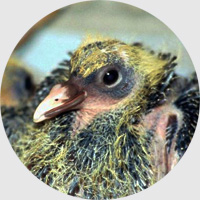
Rock Pigeon Nestling
To prevent pigeons from re-nesting on your balcony, clean off the balcony when the babies leave - remove all nesting material, clean the feces (be sure to wear a mask and gloves while doing this, and wet down the area to prevent airborne dust), and remove any unnecessary objects from the balcony - pigeons like to build nests in protected areas such as behind planters, tires, and boxes, so removing these objects makes the area less appealing as a nest site. Next, you can make their perching spots less hospitable by installing a single strand of wire above the balcony railing and any other ledges they are perching on. You can also use spiked porcupine wire or coiled wire, all of these should prevent pigeons from being able to perch on the railing (their feet cannot grip fine wire).

Mylar
Finally, loosely stringing strips of mylar (you can buy it at some garden centres or in the camping section of department stores in the form of an emergency blanket) across the balcony in the nesting area may also be effective in deterring pigeons. Mylar creates a play of light that birds dislike.
Mourning Doves
These delicate light brown birds are named for their sorrowful call, but the sound many people associate with mourning doves the airy whistle made by their feathers when they burst into flight - which they often do! Since mourning doves eat seeds almost exclusively, they spend a lot of time on the ground. Their rapid upward flight helps defend them against ground predators, but unfortunately mourning doves are still particularly vulnerable to attacks from domestic cats. This is especially true with baby doves, as they normally leave the nest before they are able to fly. It is very important not to let your pet cats roam free - keep them inside or consider an outdoor enclosure to keep both cats and wildlife safe.
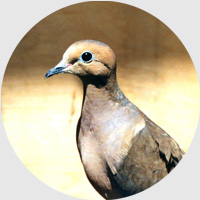
Mourning Dove
Mourning doves are well-adapted to living alongside humans, and they frequently nest in hanging planters, shrubs, hedges, and building vines. Baby doves are covered in fine cream-coloured hairs at hatching. These chicks (usually two) leave the nest when they are two weeks old - and sometimes earlier - and hop around the surrounding areas for another week or two while they are learning to forage and fly.
Like their pigeon cousins, mourning doves feed their young babies a unique substance known as “crop milk.” It isn't like the milk mammals produce, but it's comparably high in protein and fat - it's actually made from cells shed from the lining of the parents' crops (the crop is an internal sac-like organ that all birds have, where food can be stored before it moves to the stomach. Pigeons and doves have large crops, which allows them to eat a large number of seeds at one time, and then fly to a perch to slowly digest them.) Instead of gaping their mouths open for food like many other baby birds do, doves stick their beaks inside their parents' beaks so they can eat directly from their parents' crops.
American Robins
The robins we get in Canada are American robins too - the name separates these robust thrushes from European robins, who are in the flycatcher family, and it doesn't depend on the bird's home location.
Robins are excellent parents, who are fiercely protective of their young and their mates. During breeding season, male robins will compete with other males in the area, and it isn't unusual for male robins to attack their window reflections at this time of year. Toronto Wildlife Centre's hotline receives many calls from homeowners in the spring who are perplexed at the seemingly suicidal robins who are flying repeatedly into their reflective windows or car mirrors.
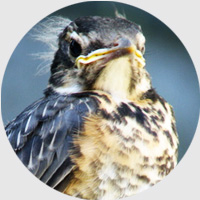
A Robin Fledgling
Baby robins have bold black spotting on their breast with a reddish hue (which will later turn into a solid red breast like their parents have). Parents will watch over their often flightless youngsters after they have left the nest, usually squawking at anyone who approaches, and bringing food to their babies on the ground. Robin parents are such attentive feeders, in fact, that they have been known to feed other babies who happen to be in the area, even if they aren't their own. We have even had a report of a robin feeding Koi fish in a person's pond. The fish would bob their puckering mouths to the surface of the pool, and the robin would fill them with food!
Robins are well-adapted to life with humans, and frequently nest in backyard trees, shrubs, and on lampposts. However sometimes people mistakenly think they've found a robin's nest when they find blue eggs - while robins do lay baby blue eggs, they certainly aren't the only species that does so. Blue is actually a very popular egg colour.
The song of the robin is pretty easy to pick out - it's usually the first one you'll hear as the sun comes up, and the last one to stop before the sun goes down. People say it sounds like "cheer-up, cheerily, cheerio!"
Canada Geese
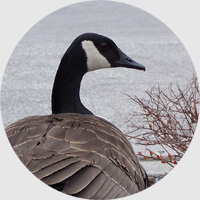
Nesting Canada Goose
These regal birds, so much a part of our Canadian heritage, have unfortunately suffered much persecution as a result of their attraction to managed landscapes (such as golf courses, commercial lawns, and parking lots), which often leads to conflict with people. Canada geese often nest in these areas since they can walk around easily (tall grasses can be a challenge for their wide-set legs), and see potential predators coming at a distance.
Canada geese mate for life, and the ganders are known to be very defensive when their ladies are on the nest, chasing and flying at anyone or anything who comes near during the month-long incubation period. Within about 24 hours of hatching, mom and dad walk their babies away from the nest to the closest water source - the babies can walk surprising distances for their size, and this trek is often through dangerous areas and across roads. Although this can be a treacherous journey, a lot of geese make it through without a scratch. Attempting to intervene by chasing the family or trying to catch and relocate them often ends up making it worse, so if you see a family that may be in danger, it's usually best to help them by making others aware of their presence (i.e. waving at cars or passersby) so they can go along on their way.
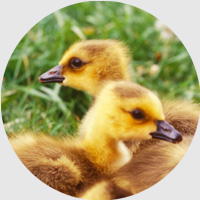
Goslings
Geese are loyal to each other, their young, and their nest sites. If the same site is available, couples may return the following year to nest again, however if the site is inappropriate (due to a danger to the geese or to people passing by the nest), they can be discouraged by either letting grass and vegetation grow tall around the area, or by erecting a collection of flags or other objects that are the same height as geese and move in the breeze.
Canada geese moult (shed and re-grow) their flight feathers around June or July. During this time geese typically have a family of downy youngsters with them also cannot fly (since they have not grown their feathers in yet), so during this short period the whole family is bound to the ground!
Mallards
Male and female mallards look different from one another (a feature known as sexual dimorphism). Female mallards have a pale brown and white colouration, but the males are dressed to impress - once they are mature, they have dazzling green heads. Both sexes have a bright blue bar on the wing.

Mallards
Mallards are a familiar neighbourhood duck to just about anyone with a water source nearby, whether a lake, pond, water reservoir, or backyard pool. In fact mallards are notorious for nesting in backyards with pools, though the nests are usually hidden behind a shrub or other vegetation, and often go unnoticed for long periods of time. Though these single moms no doubt appreciate a place to take a dip so close by, pools can be a danger for the babies, who normally follow their mothers on foot to the closest water source after hatching.
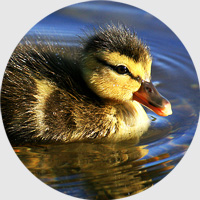
A Baby Mallard
If the pool is accessible she may encourage them to take a dip there first, but this type of human-construction presents a problem for babies - since they cannot jump up over the lip of the pool and cannot fly out, they do require a hand in getting out of the pool. A homemade wood or styrofoam ramp usually does the trick! (If this doesn't work, contact a wildlife rehabilitator for further advice)
Providing there are no obstacles like swimming pools, mallard ducklings leave the nest shortly after hatching and follow their mother on foot to the closest water source, which may be several kilometres away. The babies can walk surprising distances for their tiny size, though they may periodically stop to rest. Mallard ducklings like to stick close together, and will sometimes huddle up under mom's wings.
American Crows

American Crow
Crows are well-known for their intelligence - many studies have documented crows sophistication in problem-solving and tool use. For example, crows have been caught dropping nuts on the road for cars to crack, and then waiting for the traffic lights to collect their food safely! Their smarts make them highly adaptable, too - crows thrive in both rural and urban environments.
They also have rich social lives. Crows often do not breed until they are four years old, and until that time help out with younger siblings (that is, those from their parents' later nestings) at home - which means multigenerational families of up to five generations all in one area are not uncommon.
Crows typically (though not always) nest high up in the branches of coniferous trees. Babies often hop and awkwardly fly around the surrounding branches when they leave the nest. Unlike many other passerines, crows do not usually come down to the ground before they are able to fly. If you see a baby crow on the ground who cannot fly, its parents may not care for it - watch from a distance for an hour, and contact a rehabilitator if no adults are feeding it.
People who encounter baby crows are sometimes surprised that they are babies at all - once feathered, they are quite large (not too much smaller than an adult crow), and may only be given away by their short tails and blue eyes - like humans, many animal babies are born with blue eyes that later change colour.